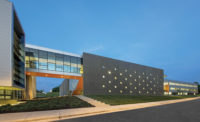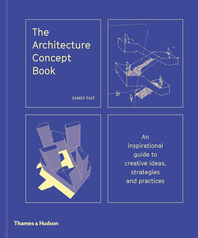The cover of the May issue of RECORD featured an unusual architectural photograph for today's world—one shot on 35mm Tri-X film. Its grainy, pre-digital quality evokes a time before Photoshop. In an interview with RECORD Art Director, Helene Silverman, the photographer who shot the image, James Ewing, discusses his love of shooting with film, and the issues surrounding much of today's digital architectural photography.
Architectural Record: What made you decide to work with film, rather than digitally, as you usually do?
James Ewing: There are essentially two answers. First, film is beautiful. And second it’s a nice break from the camera and laptop screens. It gives me more time to look at the thing I’m shooting.
I’ve been using 35mm Tri-X film: a beautiful, well-loved film that's been around for more than 60 years. It’s known for its rich tonal depth and versatility. I love the texture of Tri-X and I use a special developer to enhance it. The 35mm format is a very portable and fluid way of working and the grain is gorgeous. It’s actually surprisingly practical.
Are you disenchanted with working digitally at all?
The power of our digital tools is incredible but the technology evolves faster than we can culturally adjust. It feels good to put the brakes on occasionally. I’ve decided you don’t have to always use the latest tools.
What I really enjoy about shooting film is that it forces me to previsualize the images and shoot in a very methodical, disciplined way. It requires greater concentration and it allows me to get lost in the process of shooting. There’s also pleasure in the delayed gratification of film development. Sometimes it’s ok to wait a few hours.
What are your feelings about the way digital photos are manipulated for print? Where do you stand on the continuum of minimal to extreme Photoshop intervention?
That’s a tricky question; this is something I’ve been thinking about recently for a book I’m writing on architectural photography. It’s now very easy to turn a photograph into a rendering and sometimes it’s hard to say where the line between the two falls.
We get a lot of photos that are manipulated to a level of unreality that I can only think is asked for by the client. Have you been asked to 'purify' the photos by clients?
Architectural photography is a collaboration between photographer and architect. Some clients request more retouching than others. Often there is a hurry to do photography as soon as the building opens but there is usually some construction still going on. So we clean that mess up with Photoshop because we can. Architects are working in an incredibly competitive field and they invest a lot in photography. It’s understandable that they want the images to portray an ideal view of their work. Mostly the retouching helps the images and it’s really not a bad thing but sometimes it does go too far and it can make the images feel plastic or flat.
It would be interesting if the AIA or the architectural media as a whole decided to not accept Photoshopped images for award submissions or publication. I’m not sure how they would police this but it would really change how architectural photographers and their clients work. Some foundations that represent dead artists like Basquiat or Calder still require 4x5 film transparencies if a work is to be considered for authentication, they won't accept digital images. The New York Times is pretty strict with its photographers about no Photoshop and no retouching. But that is journalism, architectural photography is not journalism and photography is never objective.
Images are always made according to the motivations of their creators’ – that isn’t new to the digital age. And regardless of whether an image is shot digitally or on film, architectural photography is always more illustration than documentation. Architectural photographers generally try to shoot in a way that celebrates and foregrounds the work of the designer. We make many subjective decisions to interpret and translate what’s essentially a four-dimensional experience into a two-dimensional image.
I like shooting more than retouching, so for my film work I’ve decided not to use Photoshop. I scan the film because the means of distribution are digital and to have an audience the images need to be digitized. I adjust the images as I would a darkroom print but leave it there. I don’t claim this work is any more objective than my digital work but it's different for sure. It’s refreshing to see images that haven’t been heavily Photoshopped. Just like with cooking, or painting, or any art, there’s a point where things can get overdone...where it would have been better to do less.
How do you think clients would respond to you work using film, or what would be your ideal use for this kind of work?
I’d love to shoot more film for editorial. I hope to reach clients willing to let go of some of the retouching control – those interested in a less Photoshopped look and feel. Editorial clients might see commissioning film photography as a way to bring their audience an alternate viewpoint.
Where did you shoot our cover photo from and why did you choose this subject?
The cover shot was taken from the roof of a very tall building in downtown Brooklyn. I’m looking up at midtown from very far south. The New York skyline is wonderfully compressed when you see it from the south or north. It’s amazing to see the relationships between new and old shifting in the skyline.
Do you want to say anything about any of the other images you've given us? The combination of new architecture shot in grainy black and white creates a somewhat timeless feeling that could enable you to see how these buildings might appear at a time when they are part of the fabric of New York, rather than the newest thing.
I’ve made a point to shoot new buildings rather than the just the classics with this work. Shooting these newcomers with black and white film is a kind of test to see how will they hold up. It's also a way for me to integrate them into my mental map of the city. I’m trying to see them from the future by looking at them from the past. The only constant thing about this city is that it’s always changing.









